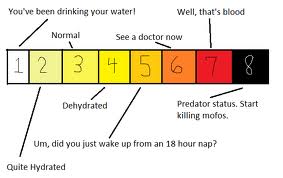“The appearance and smell of your urine can provide many clues to what else is going on in your body,” says Dr. Michael Farber, director of the Executive Health Program at Hackensack University Medical Center in Hackensack, N.J. You can tell a lot about your health by the color, and the composition, of your urine. Many tests are being developed to screen for serious diseases by checking the urine.

Image Credit: steveinevitable.com
Here are some facts about urine colors and what they mean based on CollectiveWizdom.com
- Pale Yellow, Clear or Cloudy – Normal, if pale yellow. A chemical called urochrome is responsible for tinting normal urine a shade of yellow. The more water you drink, the clearer is your urine. Murky urine or cloudy can be caused by kidney stones or urinary tract infections. Cloudy urine in particular can indicate cystitis. Urine which has absolutely no color or is absolutely clear is a symptom of diabetes insipidus.
- Brown – Fava beans, aloe and rhubarb. Medical conditions such as liver cirrhosis and hepatitus and acute glomerulonephritis. Medications such as chloroquine and nitrofuratoin,metronidosole and laxatives with cascara and senna. If you are not eating any of the foods which can turn urine brow, see a doctor for a full blood screening.
- Deep Yellow Orange or Amber – Dehydration is the most common cause of dark orange urine. Colored drinks can produce this color. Carrots, Vitamin C and foods high in carotine can also produce orange urine. Medications which can turn your urine orange include Pyridium and Coumidin.
- Bright Yellow – Excess B vitamins. Reduce or eliminate all B vitamin pills or supplements. If the color persists, cut back on foods rich in B vitamins such as whole grains.
- Red – Red urine can also indicate the presence of blood in your urine (a condition called hematuria) which can be caused by exercise, a urinary tract infection or blood from your kidneys. Blueberries, colored cereals, colored drinks such as kool-aid, beets and boysenberries can sometimes change your urine color to a shade of red.
- Blue or Dark Green – “Blue diaper syndrome” (familial hypercalcemia) is a rare cause of blue urine. More common causes are dyes in medications such as Urised, Trac tabs, amitriptyline, Tagamet, indomethacin. Certain multivitamins can also turn urine blue.





